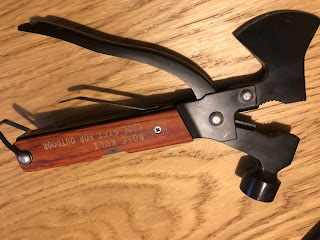 |
A place for me to review the various rugged, nifty and needful kit that I've accumulated, for every-day preparedness in the event of accident, disaster or world-shifting end-times Apocalypse, be it zombies, triffids or Mayan divide-by-zero errors.
Thursday, February 8, 2024
Prepping shed
Tuesday, January 9, 2024
Review: Rose Kuli hammer multitool
Prominently featuring a split hatchet head and a hammer head, the jaws opening up to expose pliers and cutters, with a spring assist for the plier arm. The Rose Kuli tool features red wood scaled handles, screws recessed in at the high end and riveted at the bottom end, the plyer-arm retaining loop seats into a notch in the bottom of the plyer arm, preventing the plyer head from opening up unexpectedly.

The plyer jaws have both a fine toothed and a broad toothed section, for both fine and coarse tasks as well as a 1cm (2/5") cutting jaw, for wire or nail cuttings.
The hammer itself drives nails quite well, for such a light tool at 400g (14oz), and I could tap one into my new treated-pine fence-posts with ease. The wood scales and plyer arm make for a comfortable grip on the palm and fingers. the hammer-side handle-face holds a surprise in the form of a selection of folded tools.There are 5 fold-out "blades" to further supplement the tools over-all utility. From left to right there is a simple leaf-point single edge blade, a Phillips head screw-driver, a wood-saw with fish-hook disgorger tip, a 4-size hex nut wrench (5,6,7,10mm) with bottle-opener and pry head, and a serrated blade with a file and flat-head driver tip. I would have liked a can-opener, and none of the tools lock, but each are functional.
As Corb Lund would sing "Well it's a vise grips for pliers, and pliers for a wrenchA wrench for a hammer, hammers everything else"
It came in a flimsy nylon sheath with a hook and loop flap that barely covers the heads, leaving the edge of the hatchet somewhat exposed.
For a light-weight tool, it certainly bridges the gap between belt-multitool and camp-hatchet.






